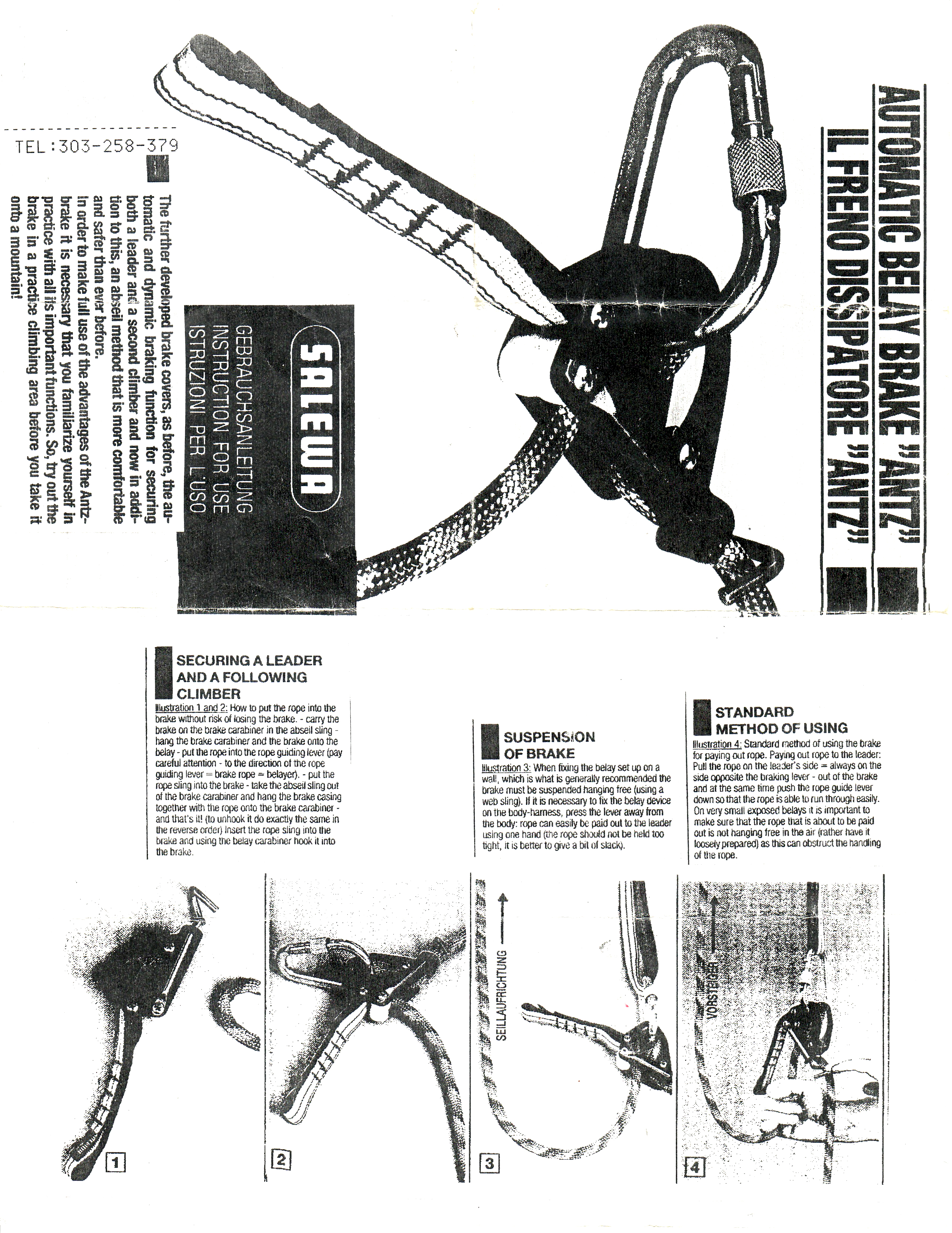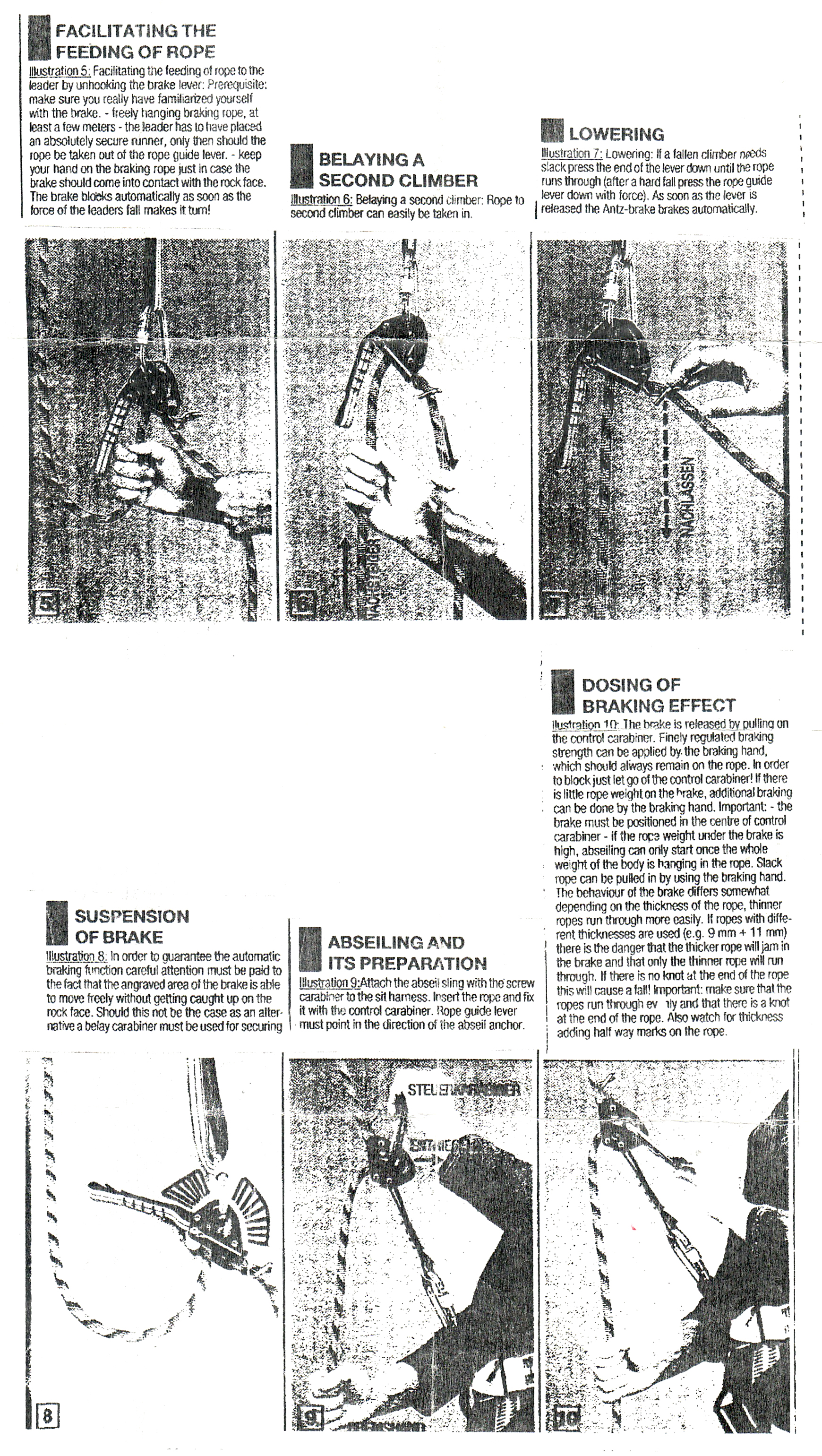Overview
[ Top
| Version B
| Return to Rotating Autoblocks
]
Version A
(#682)
Technical Details
I acquired my Salewa Antz from Ragged Mountain Equipment in 1994.
My Antz is 66 mm. long, 116 mm. wide, 42 mm. high, and weighs 172 g.
The Salewa Antz consists of two stamped 5.1 mm. aluminum plates separated by 25 mm. Each plate has a 50 mm. long, 19 mm. wide arcuate slot for an HMS carabiner, and a 13.8 mm. lightening hole. Between the plates is an aluminum block with shallow U-grooves on two sides and a rounded edge on the bottom, a nylon roller mounted on an axle, and a pin that supports a 20 mm. sewn sling. These parts are held in place by Philips-head machine screws. The rear plate has a bent tab with a hole to guide a6.1 mm. guide rod. The guide rod is screwed to the nylon roller axle for support. The upper end is bent into a rectangular coil.
The front is stamped with "SALEWA" inside an oval, "AUTOMATIC-BREMSE MOD. ANTZ," and "NR. 1620." The rear plate is stamped with arrows showing the rope path and "ROPE."
The Salewa Antz is rigged by inserting a bight into the left
side (as shown) and clipping an HMS carabiner through the slots
and the bight. The HMS is anchored appropriately. The rope to
the climber is then threaded through the coil of the guide rod.
Rope is fed by letting the HMS carabiner move to the right and
down. During a fall, the Antz is pulled into the orientation shown,
and the HMS carabiner is pulled to the left, wedging the rope
between an aluminum block on top (not visible) and a nylon roller
below.
Rappelling with the Antz is done by clipping the sling to the
seat harness, and inserting an HMS carabiner into the slot, trapping
a bight in the same manner as when belaying, The top guide is
not used, and the HMS carabiner is not clipped to the rappeller.
Since this leaves the Antz in the locked off position, the rappeller
must pull on the HMS carabiner to descend. This requires too much
effort for my taste.
I found manual for the Antz online around 2000, and it gave a different method for rappelling. The recommendation was to clip into the HMS carabiner and rappel as one would on a belay tube.
I do not like the way that the rope runs over a nylon roller.
Under load, there is too much potential for the roller to seize,
which will result in glazing the rope.
Helmut Antz applied for a patent on December 27, 1985 and received German Patent #3,546,181 in 1987.
[ Top
| Version A
| Return to Rotating Autoblocks
]
Version B
(#2840)
Technical Details
I acquired my Salewa Antz from I acquired my Salewa Antz, Version B from Marty Karabin in 2021.
My Antz is 67 mm. long, 115 mm. wide, 49 mm. high, and weighs 155 g.
Version B is missing the webbing strap found on Version A.
The front is stamped with "SALEWA" inside an oval, "AUTOMATIC-BREMSE MOD. ANTZ," and "NR. 1620." The rear plate is stamped with arrows showing the rope path and "ROPE."
Marks on the pin that this Antz once had a webbing sling and that it was removed by a previous owner. If so, this should not be considered a different version.
The nylon roller turns freely, but a worn rope groove shows that it can bind under load. Relying on a drilled nylon roller turning smoothly on a metal rod is excessively optimistic, and not recommended.
[ Top
| Version A
| Version B
]




